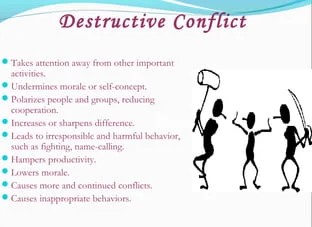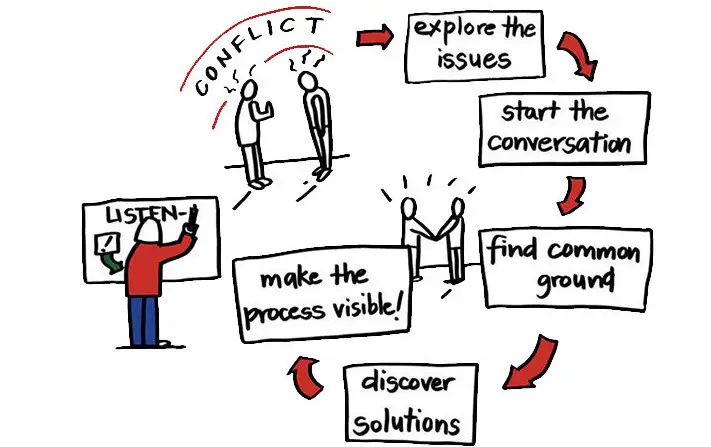Conflict is an inevitable part of human interaction, whether in personal relationships, workplaces, or within communities. It stems from differences in values, beliefs, and goals. Recognizing the nature of conflict is crucial because not all conflicts are harmful; some can spur innovation, growth, and strengthen relationships when managed well.
The difference between constructive and destructive conflict lies primarily in their outcomes and management strategies. Constructive conflict leads to positive growth, problem-solving, and enhances cooperation among parties. It is characterized by respectful communication and a focus on finding mutually beneficial solutions. In contrast, destructive conflict results in resentment, breakdowns in communication, and can cause long-lasting damage to relationships.
Understanding the dynamics of these conflicts equips individuals and organizations with the tools to foster a productive environment. It is not about avoiding conflict but rather about steering it in a direction that promotes understanding, respect, and constructive outcomes. Identifying the nature of a conflict early on can be instrumental in determining its resolution path, making it crucial for effective leadership and personal development.

Conflict Basics
Types of Conflict
Conflicts arise in various forms and contexts, impacting personal relationships, workplaces, and broader societal interactions. Understanding the different types of conflict is crucial for effective resolution and management. Here are the primary categories:
- Interpersonal Conflict occurs between two or more individuals when their ideas, needs, or values clash. It’s the most recognized form, often fueled by personal emotions and perceptions.
- Intrapersonal Conflict involves a conflict within oneself, usually related to making decisions or resolving internal dilemmas.
- Organizational Conflict emerges within or between groups in a workplace, often due to task dependencies, competition for resources, or differing goals.
- Intergroup Conflict happens between different groups or teams, driven by competition, resource allocation, or differing objectives.
Role in Growth
Conflict, often viewed negatively, plays a vital role in growth and development across personal and professional spheres. Here’s how:
- Personal Development: Engaging in conflict allows individuals to confront and overcome personal challenges, fostering self-awareness and emotional growth.
- Innovation: In organizations, conflict can spark creativity and innovation as differing perspectives clash and merge to create new ideas.
- Relationship Strengthening: Properly managed conflict can strengthen relationships by encouraging open communication and mutual understanding.
- Social Change: On a larger scale, conflict can be a catalyst for social change, driving communities and societies to address and rectify systemic issues.
Constructive Conflict
Definition
Constructive conflict, also known as functional conflict, refers to a disagreement that leads to positive outcomes. It arises when the conflict is managed effectively, encouraging open dialogue, problem-solving, and growth.
Characteristics
Key features that define constructive conflict include:
- Respectful Communication: Parties engage in honest, respectful dialogue, valuing each other’s viewpoints.
- Focus on Issues: The conflict centers around issues or tasks rather than personal attacks.
- Collaborative Problem Solving: There is a collective effort to find solutions that benefit all involved parties.
Benefits
Constructive conflict offers several advantages:
- Enhanced Problem Solving: By considering diverse viewpoints, more comprehensive and creative solutions emerge.
- Improved Relationships: It builds trust and improves interpersonal dynamics through successful conflict resolution.
- Increased Engagement: Parties involved feel more invested in the outcome, leading to increased motivation and commitment.
Examples
Real-life scenarios include a team brainstorming session where differing opinions on a project lead to a more robust strategy, or a couple resolving a disagreement through open communication, deepening their relationship.
Destructive Conflict
Definition
Destructive conflict, or dysfunctional conflict, detracts from individual or group goals, characterized by negativity and a lack of resolution. It can damage relationships and hinder growth.
Characteristics
Destructive conflict is marked by:
- Personal Attacks: The focus shifts from the issue to personal criticism.
- Avoidance or Escalation: Parties either avoid addressing the conflict or engage in escalating hostility.
- Win-Lose Mentality: One party seeks to win at the expense of the other, undermining cooperation.
Consequences
The repercussions of destructive conflict include:
- Damaged Relationships: Trust and respect are eroded, leading to ongoing animosity.
- Reduced Productivity: In workplaces, it can lead to decreased motivation and efficiency.
- Emotional Distress: Prolonged conflict contributes to stress, anxiety, and decreased well-being.
Examples
Examples encompass a workplace where persistent conflicts between departments impede project progress, or a family dispute where communication breaks down, leading to estrangement.
Key Differences
Overview
At the core, the main distinctions between constructive and destructive conflict lie in their outcomes, approaches, and effects on relationships. Constructive conflict leads to problem-solving, encourages open communication, and strengthens relationships by fostering mutual respect. In contrast, destructive conflict results in resentment, avoids problem-solving, and often leads to a breakdown in relationships.
Impact Analysis
The impact of these conflicts is profound. Constructive conflict can enhance personal growth, team dynamics, and organizational efficiency by fostering an environment where diverse ideas and perspectives are valued. Conversely, destructive conflict can stifle innovation, erode team cohesion, and, ultimately, diminish personal and organizational growth.
Management Strategies
Effective management of these conflicts involves recognizing the type of conflict at play and applying appropriate strategies. For constructive conflict, encourage open dialogue and active listening. For destructive conflict, strategies may include mediation, setting clear boundaries, or, in some cases, separation or intervention.
Identifying Conflict Types
Indicators
To identify whether a conflict is constructive or destructive, look for signs such as the tone of communication, the presence or absence of respect, and whether the focus is on the issue at hand or personal attacks.
Assessment Tools
Several tools and frameworks can help assess conflict types, including the Thomas-Kilmann Conflict Mode Instrument (TKI) and the Conflict Dynamics Profile. These tools provide insights into conflict styles and dynamics, aiding in more effective management and resolution.
Transforming Conflict
From Destructive to Constructive
Transforming conflict from destructive to constructive involves a shift in mindset, communication patterns, and conflict resolution strategies. Steps for transformation include:
- Acknowledging the conflict and its negative impacts.
- Fostering an environment of trust and openness.
- Encouraging empathy and understanding of diverse perspectives.
Conflict Resolution Skills
Essential skills for managing conflict effectively include active listening, empathy, clear communication, negotiation, and problem-solving. Developing these skills can turn potentially destructive conflicts into opportunities for growth and learning.
Role of Communication
Communication in Constructive Conflict
In constructive conflict, communication is characterized by openness, honesty, and a focus on finding a mutually beneficial solution. Techniques to enhance communication include:
- Active listening and empathetic responses.
- Use of “I” statements to express feelings and needs without blaming.
- Seeking common ground and collaborative solutions.
Communication in Destructive Conflict
Destructive conflict often features poor communication, including personal attacks, avoidance, and escalation. To avoid these pitfalls:
- Refrain from attributing blame and focus on the issue.
- Take breaks if emotions run high, to prevent escalation.
- Work towards understanding the underlying needs and concerns of all parties involved.
Frequently Asked Questions
What is Constructive Conflict?
Constructive conflict occurs when the parties involved in a disagreement use it as an opportunity for growth, innovation, and strengthening relationships. It is marked by open communication, a willingness to understand the other party’s perspective, and a focus on finding solutions that benefit all involved.
How Can Destructive Conflict Be Identified?
Destructive conflict is characterized by a lack of communication, escalating aggression, and an emphasis on winning rather than resolving the issue. It often leads to resentment, decreased productivity, and can damage relationships irreparably. Identifying it early is key to preventing long-term negative outcomes.
Why is Communication Important in Conflict Resolution?
Communication plays a pivotal role in conflict resolution by facilitating understanding, expressing needs and concerns, and finding common ground. Effective communication helps prevent misunderstandings, builds trust, and is essential for transforming destructive conflict into constructive conflict.
Can Destructive Conflict Become Constructive?
Yes, with the right approach and mindset, destructive conflict can be transformed into constructive conflict. This requires effective communication, a willingness to understand the other party’s perspective, and a focus on collaborative problem-solving. It often involves mediation or the intervention of a third party to guide the resolution process.
Conclusion
Recognizing the thin line that separates constructive from destructive conflict is essential for anyone looking to foster a healthy, productive environment. It’s not the presence of conflict that determines its impact but how it is handled. Encouraging open dialogue, practicing empathy, and focusing on collaborative solutions can turn potential confrontations into opportunities for growth.
In summary, the key to managing conflict lies in identifying its nature early on and adopting a constructive approach to its resolution. By doing so, individuals and organizations can not only avert the detrimental effects of destructive conflict but also harness the potential of disagreements to foster innovation, build stronger relationships, and achieve collective goals.

